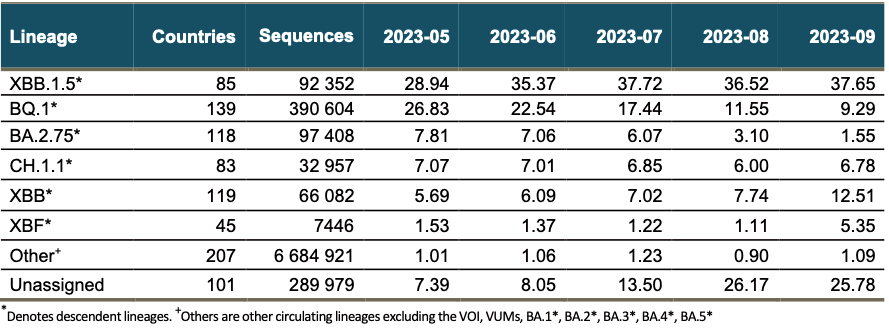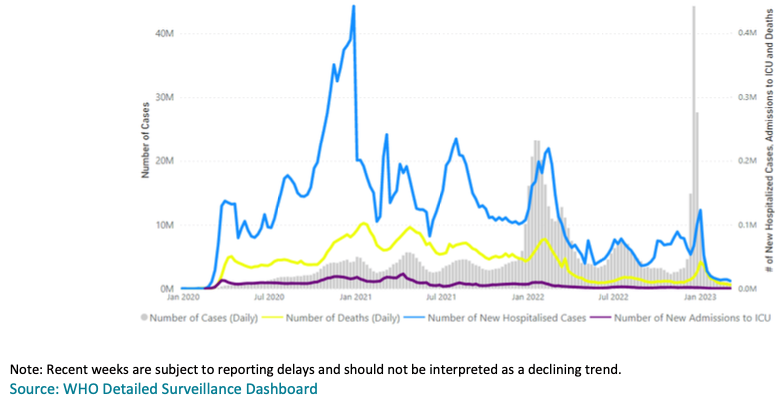
Geneva: India reported a 251% rise in new COVID-19 cases between February 20 and March 19, 2023, as compared to the previous 28-day period of January 23 to February 19, 2023, the latest World Health Organization (WHO) data released today, showed. The country reported the highest proportional increases in such cases — 10,503 versus 2,996 new cases, which though, means less than 1 new case per 100,000 population. During the period, India reported 42 new deaths – a 56% increase but which is less than 1 new death per 100,000 population.
It may be mentioned that yesterday Indian Prime Minister Narendra Modi reviewed the emerging situation and directed authorities to take adequate steps to check the rise in COVID-19 as well as influenza cases.
Globally, over 3.7 million new cases and over 26 000 deaths were reported in the last 28 days (February 20 to March 19, 2023), a decrease of 31% and 46%, respectively, compared to the previous 28 days (January 23 to February 19, 2023).
However, WHO said there are significant regional differences including increases in some regions. As of March 19, 2023, over 760 million confirmed cases and over 6.8 million deaths have been reported globally.
At the country level, the highest numbers of new 28-day cases were reported from the United States of America (792,202 new cases; -29%), the Russian Federation (339,564 new cases; +25%), China (320,029 new cases; -50%), Japan (291 672 new cases; -73%), and Germany (281,468 new cases; -18%).
The highest numbers of new 28-day deaths were reported from the United States of America (8187 new deaths; -39%), the United Kingdom (2474 new deaths; -9%), Japan (1898 new deaths; -71%), Brazil (1587 new deaths; -15%), and China (1472 new deaths; -85%).
Globally, from February 20 to March 19, 2023 (28 days), 64 775 SARS-CoV-2 sequences were shared through the Global Initiative on Sharing Avian Influenza Data (GISAID).
Currently, WHO said it is monitoring one Variant of Interest (VOI), XBB.1.5, and five variants under monitoring (VUMs). The VUMs are BQ.1, BA.2.75, CH.1.1, XBB and XBF.
It pointed out that in epidemiological week 9 (February 27 to March 5, 2023), the prevalence of XBB.1.5 was 37.7%, an increase when compared to epidemiological week 5 (January 30 to February 5, 2023), when the prevalence of XBB.1.5 was 29.0%. To date, XBB.1.5 has been detected in 85 countries.
Weekly prevalence of SARS-CoV-2 Variants of Interest and Variants under Monitoring, week 5 to week 9 of 2023

A comparison of sequences submitted to GISAID from week 5 to week 9 shows declining or stable trends for all VUMs except XBB. BQ.1 declined from 26.8% to 9.3% and BA.2.75 from 7.8% to 1.6%, while CH.1.1 and XBF remained stable (7.1% to 6.8% and 1.5% to 1.1%, respectively). XBB increased from 5.7% to 12.5%. Table 2 shows the number of countries reporting the VOI and VUMs and their prevalence from week 5 to week 9.
WHO further informed that at the global level, during the past 28 days (February 13 to March 12, 2023), a total of 54,672 new hospitalizations and 2446 new intensive care unit (ICU) admissions were reported. This represented a reduction in new hospitalizations and ICU admissions of 31% and 14%, respectively, compared to the previous 28 days (January 16 to February 12, 2023). However, it clarified that the presented hospitalization data are preliminary and might change as new data become available.
COVID-19 cases, deaths, hospitalizations, and ICU admissions reported weekly to WHO, as of March 12, 2023

Among 27 countries consistently reporting new hospitalizations, 33% (nine countries) registered an increase of 20% or greater when comparing the two 28-day periods: Tunisia (94 vs 42; +124%), the Netherlands (2470 vs 1217; +103%), Czechia (1787 vs 931; +92%), Malta (78 vs 43; +81%), Belgium (2962 vs 1684; +76%), Slovakia (1134 vs 730; +55%), Luxembourg (70 vs 46; +52%), Singapore (391 vs 267; +46%), and Ukraine (13 872 vs 9887; +40%). The highest number of new hospitalizations was reported from Ukraine (13,872 vs 9887; +40%), France (7562 vs 7711; -2%), Italy (5115 vs 6833; -25%), Greece (3710 vs 4465; -17%), Spain (3463 vs 4465; -22%), and Lithuania (3224 vs 8729; -6%).
Among 19 countries that consistently reported ICU admission data, 26% (five countries) showed an increase of 20% or greater in new ICU admissions during the 28 days period compared to the previous 28 days. These were Singapore (16 vs three; +433%), the Netherlands (169 vs 70; +141%), Czechia (126 vs 73; +73%), and Estonia (eight vs five; +60%). The highest number of new ICU admissions was reported from France (722 vs 814; -11%), Ukraine (451 vs 396; +14%), Italy (215 vs 282; -24%), the Netherlands (169 vs 70; +141%), and Australia (144 vs 197; -27%).
– global bihari bureau





